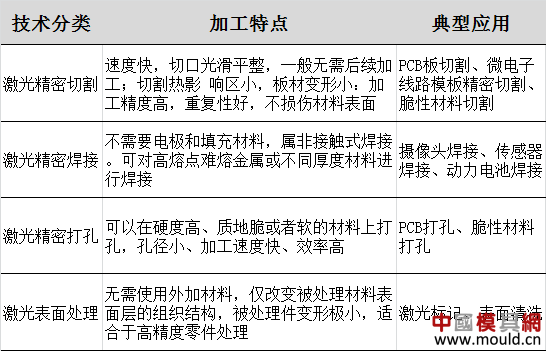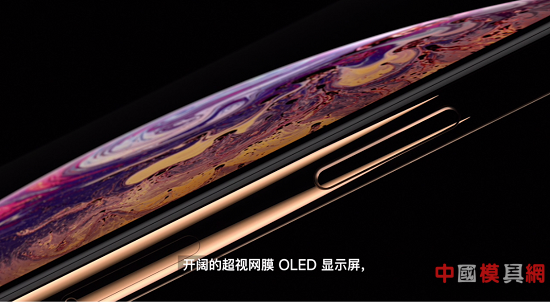At present, China's traditional manufacturing industry is facing deep transformation and upgrading, and high-end precision processing with high added value and high technical barriers is an important direction. With the increasing demand for high-precision machining, related precision machining technologies have also developed rapidly, and laser technology has gained more and more recognition in the market. The laser processing technology has three levels according to the size and processing precision of the processing materials: the laser processing technology of large-sized materials mainly based on medium and heavy plates, the processing precision is generally in the millimeter or sub-millimeter level; the precision laser mainly based on thin plates Processing technology, the processing accuracy is generally ten micron; laser micro-machining technology based on various films with a thickness of less than 100μm, the processing precision is generally below ten microns or even sub-micron. Today we mainly introduce precision laser processing. Laser precision machining can be divided into four types of applications: precision cutting, precision welding, precision drilling and surface treatment. Under the current technological development and market environment, the application of laser cutting and welding is more popular. 3C electronics and new energy batteries are the most widely used fields. Laser precision cutting Laser precision cutting uses a pulsed laser beam to focus on the surface of a machined object to form a high-energy-density spot that melts or vaporizes the material being processed at an instant. The processing characteristics are fast speed, smooth and flat cut, generally no need for subsequent processing; small heat affected zone and small deformation of the sheet: high processing precision, good repeatability, and no damage to the surface of the material. Apple mobile phone display Compared with high-power laser cutting, precision cutting generally adopts nanosecond and picosecond lasers according to the processing object, which can focus on the ultra-fine space area, and has extremely high peak power and extremely short laser pulses, which will not be processed during processing. The surrounding materials in the space range are affected, thus achieving the "superfine" of the processing. Laser precision cutting technology has unparalleled advantages in the production process of mobile phone screen cutting, fingerprint identification film, LED invisible dicing, etc., which require high precision. Laser precision welding Laser precision welding is to radiate a high-intensity laser beam onto the working area of ​​the processed product. Through the interaction between the laser and the material, the welded area is quickly formed into a multi-density heat source area, and the heat is cooled by the soldered area. Crystallization forms a consolidated weld or weld. It is characterized by the absence of electrodes and filler materials and is non-contact welding. It can weld high melting point refractory metals or materials of different thicknesses. In the field of new energy batteries, with the promotion of new energy vehicles, the demand for power batteries continues to increase. As the welding standard in the field of power battery, laser welding is widely used in the ear welding of the front section, the welding of the bottom cover, the top cover and the sealing nail in the middle section, the battery connecting piece in the rear stage, and the negative sealing welding. In the 3C field, all kinds of mobile phone modules, middle plate covers, etc. are inseparable from laser precision welding technology. Laser precision punching Laser precision drilling reduces the spot diameter to the micron level, resulting in high laser power density, and laser drilling can be performed on almost any material. It is characterized by being able to punch holes in materials with high hardness, brittle or soft texture, small pore size, fast processing speed and high efficiency. What are the applications of laser precision machining? PCB punch sample Laser drilling is the most widely used in the PCB industry. Compared with the traditional PCB drilling process, the laser not only has a fast processing speed on the PCB, but also can realize the drilling of small holes, micro holes and invisible holes below 2μm which cannot be realized by conventional equipment. hole. On the surface of electronic products, it can also be used for drilling holes in mobile phone speakers, microphones and other glass. Laser surface treatment Laser surface treatment is a surface treatment of a metal with a high power density laser beam, which can change the metal material by chemical transformation of phase transformation hardening, surface amorphization, surface alloying or vaporization or color change of the surface material. Surface characteristics. It is characterized in that it does not need to use additional materials, only changes the structure of the surface layer of the material to be treated, and the deformation of the treated part is extremely small, which is suitable for surface marking and high-precision part processing. Laser surface treatment can be divided into two categories depending on whether or not the substrate composition is changed. Applications that do not change the composition of the substrate include laser quenching (phase transformation hardening), laser cleaning, laser shock hardening, and laser polarization, etc., and changes in substrate composition include laser cladding, laser plating, laser alloying, and laser vapor deposition. application. Industry Status In the field of laser precision machining technology, many manufacturers around the world compete and provide various types of equipment, most of which are concentrated in Germany, Asia and the United States. With the increasingly fierce market competition environment, Chinese equipment manufacturers have entered the market with world-class technical competitiveness and lower cost solutions, which has greatly promoted the marketization of laser technology. Among the domestic laser equipment manufacturers, Dazu Laser and Huagong Laser can provide full-line laser equipment, which utilizes capital advantages and technology accumulation, and has outstanding performance in the field of precision processing, such as Delong Laser, Shengxiong Laser, Luen Laser, Yi Small and medium-sized enterprises such as flying lasers also have their own performance in the fields of brittle material processing and power battery welding. In terms of ultra-fast lasers, domestic Huari Laser, Han's Laser, Bellin Laser, Inno Laser, Caplin Optoelectronics, Nuopa Laser, and Anyang Laser are all committed to localization of laser core devices. A certain score has been achieved.
TEE Type welded/seamless X TYE ,Y TYPE
Standard: ASME/ANSI B16.9 ANSI/ASME B16.11 ANSI/ASME B16.28
BSEN10253-2 BS EN10253-4
Size:1/2''~48''(Seamless); 16''~80''(Welded)
Wall thickness: Sch5~Sch160\XXS
Manufacturing process: Hot Extruded , cold extruded ,pressed , etc.
Material:
Carbon steel:
FSGP PG370W PT370
HIGH YIELD STEEL FOR PIPELINE AND OFFSHORE FITTINGS
Stainless steel:
304/SUS304/UNS S30400/1.4301
304L/UNS S30403/1.4306;
304H/UNS S30409/1.4948;
309S/UNS S30908/1.4833
309H/UNS S30909;
310S/UNS S31008/1.4845;
310H/UNS S31009;
316/UNS S31600/1.4401;
316Ti/UNS S31635/1.4571;
316H/UNS S31609/1.4436;
316L/UNS S31603/1.4404;
316LN/UNS S31653;
317/UNS S31700;
317L/UNS S31703/1.4438;
321/UNS S32100/1.4541;
321H/UNS S32109;
347/UNS S34700/1.4550;
347H/UNS S34709/1.4912;
348/UNS S34800;
Alloy steel:
ASTM A234 WP5/WP9/WP11/WP12/WP22/WP91;
ASTM A860 WPHY42/WPHY52/WPHY60/WPHY65;
ASTM A420 WPL3/WPL6/WPL9;
Duplex steel
ASTM A182 F51/S31803/1.4462;
ASTM A182 F53/S2507/S32750/1.4401;
ASTM A182 F55/S32760/1.4501/Zeron 100;
2205/F60/S32205;
ASTM A182 F44/S31254/254SMO/1.4547;
17-4PH/S17400/1.4542/SUS630/AISI630;
F904L/NO8904/1.4539;
725LN/310MoLN/S31050/1.4466
253MA/S30815/1.4835;
Nickel alloy steel:
Alloy 200/Nickel 200/NO2200/2.4066/ASTM B366 WPN;
Alloy 201/Nickel 201/NO2201/2.4068/ASTM B366 WPNL;
Alloy 400/Monel 400/NO4400/NS111/2.4360/ASTM B366 WPNC;
Alloy K-500/Monel K-500/NO5500/2.475;
Alloy 600/Inconel 600/NO6600/NS333/2.4816;
Alloy 601/Inconel 601/NO6001/2.4851;
Alloy 625/Inconel 625/NO6625/NS336/2.4856;
Alloy 718/Inconel 718/NO7718/GH169/GH4169/2.4668;
Alloy 800/Incoloy 800/NO8800/1.4876;
Alloy 800H/Incoloy 800H/NO8810/1.4958;
Alloy 800HT/Incoloy 800HT/NO8811/1.4959;
Alloy 825/Incoloy 825/NO8825/2.4858/NS142;
Alloy 925/Incoloy 925/NO9925;
Hastelloy C/Alloy C/NO6003/2.4869/NS333;
Alloy C-276/Hastelloy C-276/N10276/2.4819;
Alloy C-4/Hastelloy C-4/NO6455/NS335/2.4610;
Alloy C-22/Hastelloy C-22/NO6022/2.4602;
Alloy C-2000/Hastelloy C-2000/NO6200/2.4675;
Alloy B/Hastelloy B/NS321/N10001;
Alloy B-2/Hastelloy B-2/N10665/NS322/2.4617;
Alloy B-3/Hastelloy B-3/N10675/2.4600;
Alloy X/Hastelloy X/NO6002/2.4665;
Alloy G-30/Hastelloy G-30/NO6030/2.4603;
Alloy X-750/Inconel X-750/NO7750/GH145/2.4669;
Alloy 20/Carpenter 20Cb3/NO8020/NS312/2.4660;
Alloy 31/NO8031/1.4562;
Alloy 901/NO9901/1.4898;
Incoloy 25-6Mo/NO8926/1.4529/Incoloy 926/Alloy 926;
Inconel 783/UNS R30783;
NAS 254NM/NO8367;
Monel 30C
Nimonic 80A/Nickel Alloy 80a/UNS N07080/NA20/2.4631/2.4952
Nimonic 263/NO7263
Nimonic 90/UNS NO7090;
Incoloy 907/GH907;
Nitronic 60/Alloy 218/UNS S21800
passes through the run of the tee. The 90 outlet iscalled the branch of the tee. A straingt tee is manufactured with all three outlets, the run as well asthe branchm the same size. A reducing tee is madewith the branch outlet smaller than the run toaccoomodate the design flow rate. Pipe Tee,Tee Pipe Fittings,Pipe Fitting Tee,Steel Pipe Tee HeBei GuangHao Pipe Fittings Co .,LTD (Cangzhou Sailing Steel Pipe Co., Ltd) , https://www.guanghaofitting.com

.ASTM / ASME A234: WPB - WPC - WP1WP11 - WP12 - WP5 - WP22 - - WP91
ASTM / ASME A/SA 420: WPL6 - WPL3EN 10216-2: P195GH - P235GH - P265GH-P355Nh
20MnNb6 - 16Mo3 - 8MoB5-4 - 14MoV6310CrMo5-5 - 13CrMo4-5 - 10CrMo9-10-15NiCuMoNb5-6-4 - X11CrMo5X11CrMo9-1 - X10CrMoVNb9-1X10CrWMoVNb9-2 - X20CrMoV11-1former BS-DIN-AFNOR equivalent grades)
ASTM A860 / MSS-SP75: WPHY 42WPHY 46 - WPHY 52 - WPHY 60-WPHY 65 - WPHY 70 grades
WPHY 80 only as per MSS-SP75 EN 10208-2: L245NB - L290NBL360NB - L415NB - L360QBL415QB - L450QB - L485QB - L555Q
What are the applications of laser precision machining?
Next Article
Vortex flowmeter troubleshooting